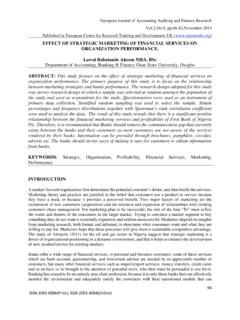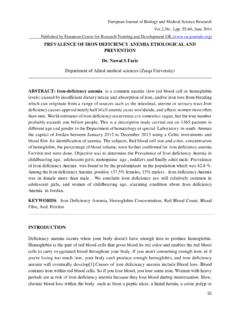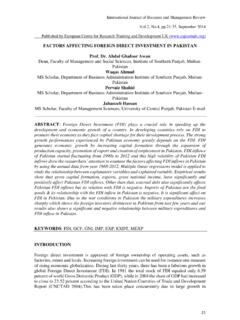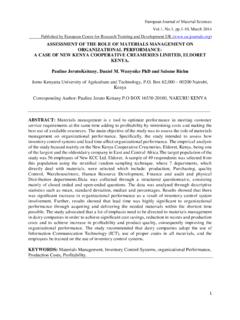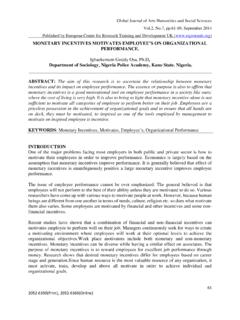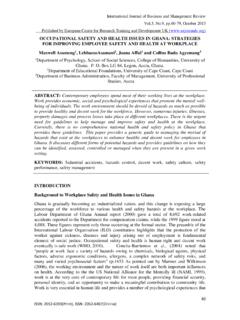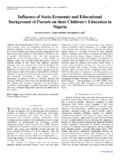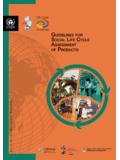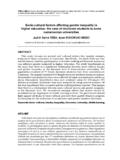Transcription of THE RELATIONSHIP BETWEEN SOCIO-ECONOMIC …
1 European Journal of English Language and Literature Studies , , , March 2014 Published by European Centre for Research Trading and Development UK ( ) 49 THE RELATIONSHIP BETWEEN SOCIO-ECONOMIC STATUS AND ACADEMIC ACHIEVEMENT IN THE EFL CLASSROOM AMONG IRANIAN UNIVERSITY STUDENTS Farid Ghaemi, Assistant Professor in TESL/TEFL Islamic Azad University-Karaj Branch Mahbubeh Yazdanpanah, PhD Candidate in TEFL Instructor in Hazrate Narjes University of Rafsanjan ABSTRACT: Numerous studies have shown that the socioeconomic (SES) achievement gap is the main cause of inequality of students in schools and other educational systems (Bourdieu 1989; Carnoy 2007; Shavit and Blossfeld 1993, as cited in Doren, 2013). The most significant reason of this finding according to Battle and Lewis (2002) might be the fact that a person s education is clearly linked to their life chances, income and well-being. The low status students compared with the mid/high status students are often more depressed and they are concerned about their financial problems and sometimes they don t have enough time for studying and other academic activities.
2 As such, besides providing the educational materials and facilities to promote learning and achievement in academic settings, the socioeconomic status of the students or their family could be a factor which impacts on their emotional state and motivation for their learning. Stern (1963, as cited in Burstall, 1975) also stated that there is a serious need to study motivational factors which may result in the students development of positive or negative attitudes toward foreign language culture, language itself, and people of the foreign country, which may have hindering or facilitating results on the foreign language development. As some researchers such as Gayton (2010) also have recognized, while the influence on language-learning motivation of other macro -level factors, such as gender, have been extensively investigated, there has been comparatively little written about an association BETWEEN SES and language- learning.
3 Particularly, in Iran and even more evidently among the university students, differential achievement along the lines of SES has not been central to investigation in the realm of educational attainment. This is while the problem of socioeconomic status is getting more and more tangible in universities due to its impacts on the students academic achievement and even sometimes it causes some students put aside their education. Thus, it is important to have a clear understanding of what benefits or hinders Iranian university-age students educational attainment. As such, the present research aims to investigate the effects of the SOCIO-ECONOMIC status on EFL sophomore learners academic achievement in the national university of a town in Iran named Rafsanjan. KEYWORDS: SOCIO-ECONOMIC Status, Academic Achievement, EFL, Iranian University Students European Journal of English Language and Literature Studies , , , March 2014 Published by European Centre for Research Trading and Development UK ( ) 50 INTROODUCTION SOCIO-ECONOMIC Status According to American Psychological Association (APA), socioeconomic status is commonly conceptualized as the social standing or class of an individual or group, and it is often measured as a combination of education, income and occupation.
4 In the present study also, students' SOCIO-ECONOMIC status is identified by the information provided by a questionnaire about the participants parents and/or spouses' job, educational degree, income average and also about the number of their families' members. They are classified into two groups. The first group includes students with a mid/ high SOCIO-ECONOMIC status, and the second group contains students with a low SOCIO-ECONOMIC status. Academic Achievement The importance of adolescents' grade point average in relation to their overall academic accomplishment has been highlighted by the body of literature on academic achievement, and academic achievement is seen as adolescents' grade point averages in many academic settings. In this study also academic achievement is defined as the grade point averages of sophomore students in English language and linguistics program. These grade point averages are for the same term for all the participants of this study.
5 Research on SOCIO-ECONOMIC Status and Academic Achievement Few studies have seriously examined SOCIO-ECONOMIC status for its influence on academic achievement and the number of them is even smaller in the field of foreign language learning. Hamid (2011) examined the relationships BETWEEN secondary school students family SOCIO-ECONOMIC characteristics and their academic achievement in English in a rural sub-district in Bangladesh. The results revealed that the rural students had low levels of academic achievement in English and within this overall low level of achievement, there were patterned relationships BETWEEN the students family income and parental education and their academic achievement in English. Students who had higher levels of parental education and family income were more likely to obtain higher scores on the proficiency test as well as higher grades in English in the Secondary School Certificate examination.
6 Shamim (2011) in his study compared learners SOCIO-ECONOMIC status with their English language scores in the most recent public examination. He found that learners in the higher income bracket consistently outperformed learners in the lower income bracket. He suggested that the positive correlation of high family income with students higher levels of proficiency in English may be attributed to their earlier education in private English medium schools compared to students in the lower income bracket. Aikens & Barbarin (2008) recognized in the process of their investigation that children from low-SES environments acquire language skills more slowly, exhibit delayed letter recognition and phonological awareness, and are at risk for reading difficulties. In a study by Palardy (2008), Students from low-SES schools entered high school grade levels behind students from higher SES schools. In addition, students from the low-SES groups learned European Journal of English Language and Literature Studies , , , March 2014 Published by European Centre for Research Trading and Development UK ( ) 51 less over 4 years than children from higher SES groups, graduating grade levels behind those of higher SES groups.
7 Honea (2007) in a study examined the influence of diligence, diligence support, family SOCIO-ECONOMIC status and some other variables on academic achievement. 315 high school students, 215 parents, and 46 teachers in the rural South made the sample of his study. The RELATIONSHIP BETWEEN family SOCIO-ECONOMIC status and academic achievement was statistically significant in this investigation. Ghani (2003) investigated the effect of SES on EFL learning in Pakistan. She measured the language proficiency of the learners in three ways: by administering a past Cambridge First Certificate exam (1995) and a cloze test (Lapkin and Wsain 1977) and from the scores they had obtained in the most recent intermediate annual examination in English which the subjects had taken covering composition, grammar, translation and set texts. She found that it has an overwhelming effect on English learning success in this country.
8 Tang (2003) in a study of examining the effects of twelve variables such as self-concept, LOC, SES, and prior achievement on educational attainment found that SES and prior achievement had the largest effects on it for all ethnic and gender groups. In a study of middle school sixth grade students by Heck (1998) also students' ACH was identified to be related to their SES and LOC and can be predicted by these variables. Luster and McAdoo (1991) in a study of the adversity of achievement among Black children found that overall high achievers came from smaller families, were financially higher, and had relatively intelligent and educated mothers and a more supportive home environment than low achievers. Making a risk index for the children's cognitive and behavioral outcomes, the researchers found that those children whose family situations were positive had better cognitive and social outcomes while children who experienced multiple risks were more likely to face up to academic and adjustment problems.
9 In a study by Coley (2002), children with higher SES backgrounds were more likely to be proficient on tasks of addition, subtraction, ordinal sequencing, and math word problems than children with lower SES backgrounds. Pursley (2002) in the first study of dropout students tried to explore the development of the personal characteristics of Mexican-American dropouts during the transition to high school, discover which personal characteristics differed BETWEEN those who dropped out by the 12th grade and those who graduated, and explore differences in the development of the personal characteristics of the dropouts and graduates BETWEEN the 8th and the 10th grades. The independent variables were SOCIO-ECONOMIC status and time. He controlled for dropout-related family and school variables and explored longitudinal pattern differences in the theoretically selected personal characteristics. The sample for his study included 310 students that were selected from 1952 subjects in the existing database of the National Education Longitudinal Study of 1988 that reported being Mexican American.
10 Effects of SES and time on the dependent variable were examined. Results showed that SOCIO-ECONOMIC status had main effects for academic achievement. SOCIO-ECONOMIC status and time had also main effects for educational aspiration. Miller (1999) designed a study to examine the RELATIONSHIP BETWEEN SOCIO-ECONOMIC status, age, gender, education and locus of control (LOC). No significant correlations occurred BETWEEN SOCIO-ECONOMIC status, age, education and LOC. European Journal of English Language and Literature Studies , , , March 2014 Published by European Centre for Research Trading and Development UK ( ) 52 Davis (1998) conducted a research to examine the RELATIONSHIP of family demographic factors and some other variables with academic achievement in college students from single-parent and two-parent homes, and academic differences BETWEEN these two groups.


